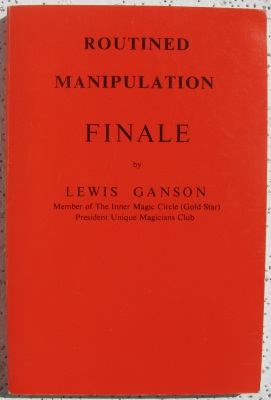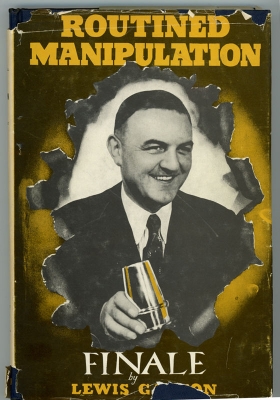©1954 Harry Stanley, Unique Magic
©1976 D.Robbins & Co., Inc.
Hardcover, 6x9", 255 pages
(D. Robbins edition - Softcover, perfect-bound)

D. Robbins Edition
Image from Magicref

Harry Stanley Hardcover
Image courtesy e-Bay seller Tork
| Ganson,
Lewis: Routined
Manipulation
Finale ©1954 Harry Stanley, Unique Magic ©1976 D.Robbins & Co., Inc. Hardcover, 6x9", 255 pages (D. Robbins edition - Softcover, perfect-bound) |
 D. Robbins Edition Image from Magicref |
 Harry Stanley Hardcover Image courtesy e-Bay seller Tork |
Comment: Photographs by Kenneth Pratt, Bill Ellis, and The
County Studio,
Farnborough. Excellent close up magic in an
inexpensive volume. Line drawings and B&W photos throughout.
There is also an edition Complete Routined Manipulation
that includes Routined Manipulation 1, 2 and Finale all in one
volume.
Contents:
5 Harry Clarke Photo: B&W photo of Harry Clarke,
publisher of magic works
9 Introduction: by Lewis Ganson, 1954
11 Section One:
Anti-Gravity
Glasses
13 Lewis Ganson Photo: B&W photo of Lewis Ganson with the cups
& balls
15 Chapter One:
A
Clear Case of Anti-Gravity: an expanded version of
The Anti-Gravity Glasses routine. The cups not only suspend
beneath the
tray, but the tray is inverted and a single cup is suspended, and
silks
are even drawn from the glasses while suspended.
23 Chapter Two:
Some
Reflections on Anti Gravity: Additional ideas
on the above routine, with discussions of gimmick designs.
26 Elizabeth Warlock's Version of the Anti-Gravity Glasses: a
silent
routine by the daughter of Peter Warlock
31 Section Two: Magic
With
Coins
32 Fred Kaps Photo: B&W photo of Fred Kaps
33 Chapter Three:
Fred Kaps Coins & Glass Routine: four coins
appear, vanish and reappear in a glass previously shown empty.
Uses the
basic slight from The Art of Magic called "Down's Latest Method
for
'The Miser's Dream'".Utilizes a handkerchief, a glass tumbler,
four
half crowns (Kaps' uses palming coins), and a coin dropper
47 Chapter Four:
Peter Warlock's Take a Bow, Jack Avis: English
Penny and Florin change places in folds of a handkerchief. Uses a
handkerchief, a Penny, a Florin, a gimmicked Penny, and a penknife
(though a marker could be used instead of the penknife).
51 Section Three: Linking
Rings
52 Ken Brooke Photo: B&W Photo
53 Chapter Five:
Ken
Brook's Linking Ring Count: A method of
counting the eight rings to accompany the Odin routine. Highly
recommends all readers to get M. Claudiu Odin's book The Odin Rings, translated by
Victor Farelli, compiled by E. Gardet, & published by Edward
Bagshawe & Co., 1931
67 Section Four: Magic
with
Dice
68 Gerald Kosky Photo: B&W photo
69 Chapter Six:
Gerald Kosky's "How Many"?: Three dice change places
in performer's hands, change size, then even become blank.
74 Chapter Seven:
Ali
Bongo's "Deolali Dice": a gimmicked dice set
that you can build. Routine is fairly short. Two small die are
poured
from a shaker cup onto the table and inserted into the right fist.
"Fertilizer" is poured over the right hand, and two large die are
dumped out, the small die are nowhere to be found. The large die
can be
examined, if necessary
81 Section Five:
Handkerchief Magic
83 Chapter Eight:
Charlie Edward's Dissolving Knots: Dissolving silk
knots and a rope through tied wrists routine.
97 Section Six: Magic
With
Sponge Balls. An excellent
treatise on sponge ball magic
99 Chapter Nine
99 Part I. Requirements and Principles: the "invention" of
sponge
balls by Jesse J. Lybarger, Al Cohn, and the contribution by Joe
Berg
(1926). Covers the type of sponge to use, how to cut the sponge,
the
basic effect, and stages of performance
102 Part 2. Adding One Ball to Another: Four methods and placing
the
balls down
106 Part 3. Two Subtle Moves: To show three balls only (in both
hands),
and The Spectator Holds a Ball (multiply in spectator's hand)
108 Part 4. Vanishes From the Hand: Five methods detailed
117 Part 5. A Sponge Ball Routine: with advice Do Not Make the
Routine
Too Long, and Build Up to a Climax. Routine combines the two in
the
hand and one in the pocket with multiplication in the spectator's
hand
119 Part 6. Accessories: brief description of other tools that
could be
helpful in a sponge ball routine such as: rubber production fruit,
sponge ball to bunny, and handkerchief pull, for examples
121 Part 7. Rabbit's Habits: Three routines for sponge rabbit sets
(good)
127 Section Seven: The
Magic of Al Koran
128 Al Koran photo: B&W
129 Chapter Ten:
Al
Koran's Simplex Torn and Restored Newspaper:
alternate
method from Routined Manipulation Parts I/II. Ganson states, "I
was
particularly impressed with the apparent absence of the
possibility of
there being any hiding place for the torn pieces..." Similar to
the Al
Baker method.
139 Chapter Eleven:
A
Pound for your Card: Spectator removes any
card
from the deck and signs it. It is sealed in an envelope. A bill is
borrowed and the serial number noted and placed in a purse. The
two
switch places. Needs just some envelopes, a purse large enough to
cover
a card, and cards.
146 Chapter Twelve:
The Fate of a Fiver: A five pound note is
torn and
restored, this is repeated and it is burned accidentally, only to
be
opened as change for a fiver, including coins. Uses fake notes
rather
than real ones, though if you don't mind destroying a bill each
performance you could use a real note...
154 Chapter Thirteen:
Hanky Panky Routine: Incorporates the following
effects - penetration of a handkerchief by a pencil, burnt and
restored
handkerchief, cut and restored handkerchief (credits Jack Chanin),
continuous production of coins from the handkerchief (also Jack
Chanin), production of a cigarette and lighter from the
handkerchief,
and production of a glass of wine (Jardine Ellis). The
handkerchief is unharmed.
165 Chapter Fourteen:
Perfection Do As I Do: Two packs of cards are
used, one is handed to a spectator. Spectator takes a card face
down
from his deck, performer removes a card from his, they are both
the
same. Performer places the Queen of Hearts down and turns the
spectator's card down, when turned up, it too is the Queen of
Hearts.
Uses the Paul Curry Turnover Change.
171 Section Eight:
Miscellaneous Magic
172 Chapter Fifteen:
Perter Burto's Burnt & Restored Paper
Strip. 18" long paper is burnt, ashes are grabbed, and the strip
is
restored from the empty hand. (uses TT)
175 Chapter Sixteen:
Hans
Trixer's
Miniature Cups & Balls: This
cups and balls routine is more of a Three Shell Game, but using
small
wooden cups similar to the Indian Style cups and balls, a small
"pea"
ball as used in the Walnut Shell & Pea, and climaxes with the
revelation of a coin under one of the cups.
180 Chapter Seventeen:
Hans
Trixer's
Silken Canary: small canary on
the
finger is thrown and changes to silk.
182 Chapter Eighteen:
Hans Trixer's Slot Machine: Two coins placed in
the left hand change to a small bottle or other object.
185 Chapter Nineteen:
John Lewis's Colour Thimbles: short color change
routine with three thimbles, each of a different color
187 Chapter Twenty:
Hans Trixer's Silk Penetro: Billiard ball
penetrates a handkerchief; no gimmicks
225 Section Ten: Card Magic by Manipulation
226 Chapter Twenty-Nine:
Some
Observations on Card Manipulation: a
description of points to be considered in a good production of
card
fans routine. Includes the Front and Back Palm, Cover for the
Pivot,
Acquitments, Stealing Extra Stocks of Cards, and Hiding the
Corners of
the Cards
230 Chapter Thirty:
Preparation of Cards for Manipulation: How to
physically prepare the cards, including: what type of card to use,
removing
stiffness, splitting, etc.
235 Chapter Thirty-One:
The
Continuous Production of Fans of Cards:
detailed description of the improved method
241 Chapter Thirty-Two:
The
Production of Single Cards: Method One if
large numbers of single cards are to be produced, and Method Two
(by
Ken Brooke) for up to 6 or 8 cards
246 Chapter
Thirty-Three:
Manipulation
in Gloves: Advantages include good
looks, no damp hands, and extra cover is provided by the gloves
251 Chapter Thirty-Four:
The
Card Routine: the full routine
outlined, using the above improved approaches
